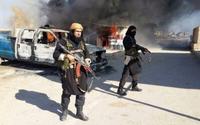-
Pentagon’s excess equipment makes local police resemble military units
In the early 1990s, Congress authorized the Pentagon to transfer excess military equipment to law enforcement agencies across the country for use in counter-drug activities. Since the program’s inception, the Pentagon has transferred $4.3 billion worth of military equipment to local and state agencies. In 2013 alone, $449,309,003 worth of military property was transferred to law enforcement. Critics say that more and more police departments now resemble military units, and that military gear is used in cases where it should not – as was the case in a small Florida town in 2010, when officers in SWAT gear drew out their guns on raids on barbershops that mostly led to charges of “barbering without a license.”
-
-
Synthetic aperture sonar to help in hunting sea mines
Mines are plentiful and easy to make. Some mines explode on contact. Others are more sophisticated, exploding or deploying torpedoes when their sensors detect certain acoustic, magnetic or pressure triggers. Some can destroy a ship in 200 feet of water. Since the Second World War, sea mines have damaged or sunk four times more U.S. Navy ships than all other means of attack combined, according to a Navy report on mine warfare. New sonar research could improve the Navy’s ability to find sea mines deep under water. The underlying technology, known as synthetic aperture sonar (SAS), uses advanced computing and signal processing power to create fine-resolution images of the seafloor based on reflected sound waves.
-
-
Technology allows human to climb like geckos
Historically, gaining the high ground has always been an operational advantage for soldiers, but the climbing instruments on which they are frequently forced to rely — tools such as ropes and ladders — have not advanced significantly for millennia. DARPA’s Z-Man program has demonstrated the first known human climbing of a glass wall using climbing devices inspired by geckos. The historic ascent involved a 218-pound climber ascending and descending twenty-five feet of glass, while also carrying an additional 50-pound load in one trial, with no climbing equipment other than a pair of hand-held, gecko-inspired paddles.
-
-
Badly engineered missile defense systems deployed “because there was a rush”
In 1983 President Ronald Reagan launched the Strategic Defense Initiative (SDI) to build space- and ground-based missile defense systems. The space-based component was abandoned as impractical, and the focus shifted to Ground-based Midcourse Defense systems (GMD). Despite disappointing results and program test failures, Congress and the George W. Bush administration pressed forward with spending billions on acquiring systems of questionable reliability. “We recognize the problems we have had with all the currently fielded interceptors,” Undersecretary of Defense Frank Kendall old an industry gathering in February 2014. “The root cause was a desire to field these things very quickly and very cheaply; we are seeing a lot of bad engineering, frankly, and it was because there was a rush.”
-
-
Number of world’s nuclear weapons reduced, but modernization continues
The overall number of nuclear weapons in the world continues to decline, but none of the nuclear weapon-possessing states are prepared to give up their nuclear arsenals for the foreseeable future. At the start of 2014 nine states — the United States, Russia, the United Kingdom, France, China, India, Pakistan, Israel, and North Korea — possessed approximately 4000 operational nuclear weapons. If all nuclear warheads are counted, these states together possessed a total of approximately 16,300 nuclear weapons compared to 17,270 in early 2013.
-
-
How has Iraq lost a third of its territory to ISIS in three days?

The Islamic State of Iraq and the Levant (ISIL), also known as ISIS, has about 12,000 fighters in its ranks. About 8,000 needed only forty-eight hours to take Mosul, Iraq’s second largest city, although it was defended by more than 27,000 government troops. It took ISIL another twenty-four hours to gain control of about one-third of Iraq – facing little, if any, resistance from Iraq’s one-million-strong security apparatus. The reasons: After the U.S. occupation force, in 2003, dismantled Iraq’s professional military, a new Iraqi army was re-established from militia members and low-ranking members of the Ba’ath army. Senior officers in Saddam Hussein’s forces were dismissed, which gave rise to at least two security issues. Firstly, military officers of the previous army were steered toward terrorist groups. Secondly, Iraq’s new military suffered from the loss of expertise and military discipline instilled by their former officers. In addition, poor governance has led to widespread corruption in both political and military spheres. Military personnel are routinely reported to be soliciting bribes, especially in Sunni areas of Iraq.
-
-
Close air support technology helps in fire suppression
In the heat of battle, lives can depend on being able to coordinate troop positions safely while directing aircraft to provide close air support for ground forces. DARPA’s Persistent Close Air Support (PCAS) program aims to help overcome those challenges by providing soldiers with advanced digital tools for situational awareness and targeting in place of legacy communications systems and traditional paper maps. Firefighters battling wildfires face challenges very similar to those that troops face in battle — the need for situational awareness, precise coordination of airborne water drops and ensuring fellow firefighters are kept safe from rapidly moving and shifting flames. Technology developed for air-to-ground warfare has been adapted to help firefighters combat deadly forest blazes.
-
-
Laser weapon developed for Marine vehicles

As the U.S. Navy prepares to deploy its first laser weapon on a ship later this summer, Office of Naval Research (ONR) officials announced that they have finished awarding contracts to develop a similar weapon to be used on ground vehicles. The Ground-Based Air Defense Directed Energy On-the-Move program, commonly referred to as GBAD, aims to provide an affordable alternative to traditional firepower to keep enemy unmanned aerial vehicles (UAVs) from tracking and targeting Marines on the ground.
-
-
The Pentagon integrates climate change into military planning
With the release of the National Climate Assessment last month, a clearer picture has emerged of the official policy-related interpretation of climate change data. The debate may still go on amongst civilian branches of government, and between the administration and its critics, the Pentagon, for some time now, has already been integrating climate change-related policies into its daily operations across all branches of the military.
-
-
Nature-inspired designs for drones of the future

Based on the mechanisms adopted by birds, bats, insects, and snakes, fourteen research teams have developed solutions to some of the common problems that drones could be faced with when navigating through an urban environment and performing novel tasks for the benefit of society. Whether this is avoiding obstacles, picking up and delivering items, or improving the take-off and landing on tricky surfaces, it is hoped the solutions can lead to the deployment of drones in complex urban environments in a number of different ways, from military surveillance and search and rescue efforts to flying camera phones and reliable courier services.
-
-
New compound offers protection against chemical weapons
Researchers have discovered that some compounds called polyoxoniobates can degrade and decontaminate nerve agents such as the deadly sarin gas, and have other characteristics that may make them ideal for protective suits, masks or other clothing. The use of polyoxoniobates for this purpose had never before been demonstrated, scientists said, and the discovery could have important implications for both military and civilian protection. A UN report last year concluded that sarin gas was used in the conflict in Syria.
-
-
Robot warfare raises ethical question
Remote-controlled drones could one day give way to automated robot forces. With the increasing use of drones in military operations, it is perhaps only a matter of time before robots replace soldiers. Whether or not fully automated war is on the immediate horizon, researchers say it is not too early to start examining the ethical issues that robot armies raise.
-
-
UN mulling rules to govern autonomous killer robots
On Tuesday, delegates from several international organizations and governments around the world began the first of many round of talks dealing with some call “lethal autonomous weapons systems” (LAWS), and others call “killer robots.” Supporters of LAWS say the technology offers life-saving potential in warfare, as these robots y are able to get closer than troops to assess threats without letting emotions interfere in their decisions. This is precisely what concerns critics of the technology. “If we don’t inject a moral and ethical discussion into this, we won’t control warfare,” said one of them.
-
-
Sandia completes overhaul of key nuclear weapons test facilities
Sandia National Laboratories recently completed the renovation of five large-scale test facilities that are crucial to ensuring the safety and reliability of the U.S. nuclear weapons systems. The work supports Sandia’s ongoing nuclear stockpile modernization work on the B61-12 and W88 Alt, assessments of current stockpile systems and test and analysis for broad national security customers.
-
-
Teams from U.S. service academies demonstrate potentially transformative technologies
DARPA’s mission is to ensure the technological superiority of U.S. military forces, and the agency continually seeks new sources of talent to accomplish that goal. The U.S. three military service academies are a promising source of that talent. The U.S. Air Force Academy team wins new competition — DARPA Service Academies Innovation Challenge — designed to encourage students at U.S. military academies to develop groundbreaking solutions to challenges facing the U.S. armed forces.
-
More headlines
The long view
Factories First: Winning the Drone War Before It Starts
Wars are won by factories before they are won on the battlefield,Martin C. Feldmann writes, noting that the United States lacks the manufacturing depth for the coming drone age. Rectifying this situation “will take far more than procurement tweaks,” Feldmann writes. “It demands a national-level, wartime-scale industrial mobilization.”
